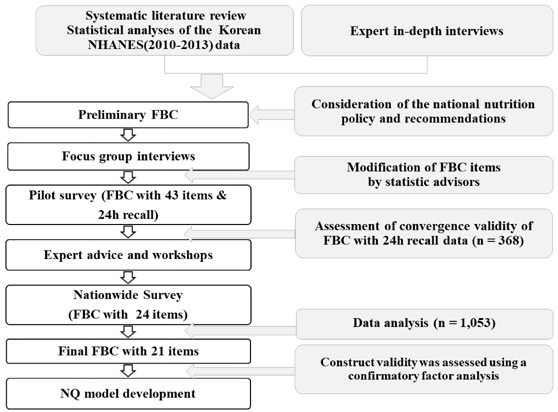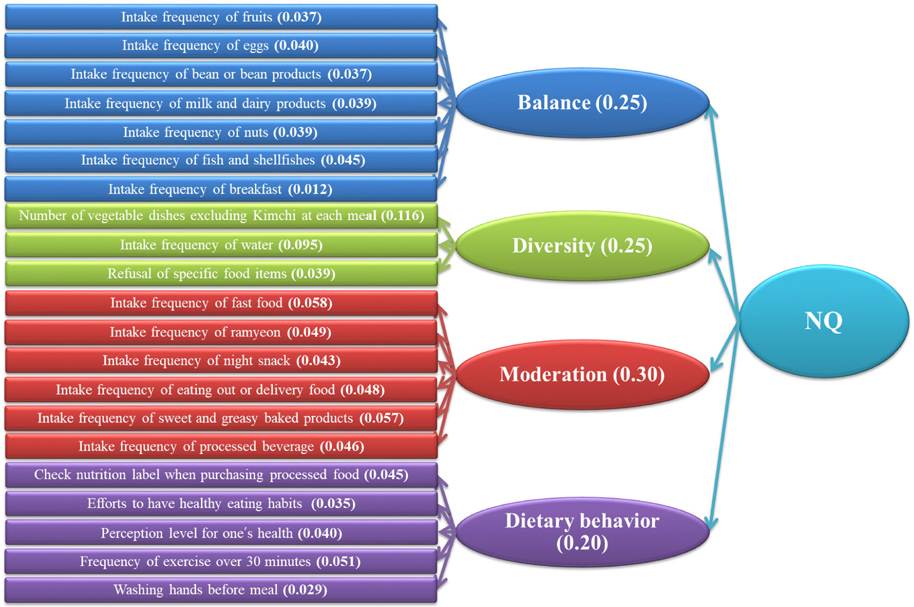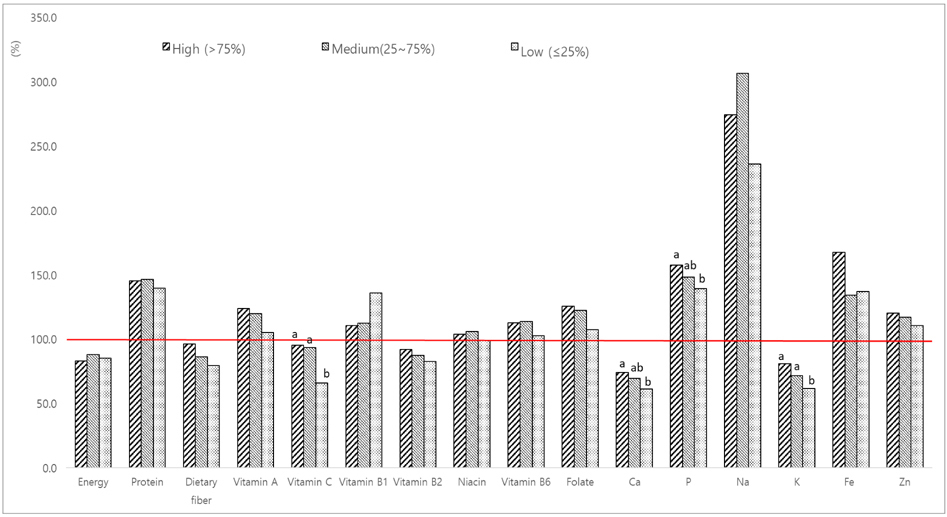J Nutr Health.
2018 Aug;51(4):340-356. 10.4163/jnh.2018.51.4.340.
Development of Nutrition Quotient for Korean adults: item selection and validation of factor structure
- Affiliations
-
- 1Department of Food & Nutrition, Kookmin University, Seoul 02707, Korea.
- 2Department of Food & Nutrition, Yong In University, Yongin, Gyeonggi 17092, Korea.
- 3Department of Foodservice Management & Nutrition, Sangmyung University, Seoul 03016, Korea.
- 4Department of Statistics, Hannam University, Daejeon 34430, Korea.
- 5Nutrition for the Future Inc., Seoul 08788, Korea.
- 6Department of Food & Nutrition, Yonsei University, Seoul 03722, Korea.
- 7Department of Food & Nutrition, Hannam University, Daejeon 34430, Korea.
- 8Department of Food & Nutrition, Daegu University, Gyeongsan, Gyeongbuk 38453, Korea. yschoi@daegu.ac.kr
- KMID: 2419505
- DOI: http://doi.org/10.4163/jnh.2018.51.4.340
Abstract
- PURPOSE
This study was conducted to develop a nutrition quotient (NQ) to assess overall dietary quality and food behaviors of Korean adults.
METHODS
The NQ was developed in three steps: item generation, item reduction, and validation. Candidate items of the NQ checklist were derived from a systematic literature review, expert in-depth interviews, statistical analyses of the Korea National Health and Nutrition Examination Survey (2010 ~ 2013) data, and national nutrition policies and recommendations. A total of 368 adults (19 ~ 64 years) participated in a one-day dietary record survey and responded to 43 items in the food behavior checklist. Pearson's correlation coefficients between responses to the checklist items and nutritional intake status of the adults were calculated. Item reduction was performed, and 24 items were selected for a nationwide survey. A total of 1,053 nationwide adult subjects completed the checklist questionnaires. Exploratory and confirmatory factor analyses were performed to develop a final NQ model.
RESULTS
The 21 checklist items were used as final items for NQ. Checklist items were composed of four factors: nutrition balance (seven items), food diversity (three items), moderation for the amount of food intake (six items), and dietary behavior (five items). The four-factor structure accounted for 41.8% of the total variance. Indicator tests of the NQ model suggested an adequate model fit (GRI = 0.9693, adjusted GFI = 0.9617, RMR = 0.0054, SRMR = 0.0897, p < 0.05), and item loadings were significant for all subscales. Standardized path coefficients were used as weights of the items. The NQ and four-factor scores were calculated according to the obtained weights of the questionnaire items.
CONCLUSION
NQ for adults would be a useful tool for assessing adult dietary quality and food behavior. Further investigations of adult NQ are needed to reflect changes in their food behavior, environment, and prevalence of chronic diseases.
Keyword
MeSH Terms
Figure
Cited by 2 articles
-
Application and evaluation of mobile nutrition management service for breast cancer patients
Ji Hee Choi, Seon-Joo Park, Hee Kwon, Hae-Jeung Lee
J Nutr Health. 2020;53(1):83-97. doi: 10.4163/jnh.2020.53.1.83.Evaluation of the nutrient quotient for the elderly (NQ-E) using congregate meal services according to their oral health conditions
Na-Young Yi, Jung-Hwa Choi
Nutr Res Pract. 2022;16(5):628-645. doi: 10.4162/nrp.2022.16.5.628.
Reference
-
1. Lim J, Lee Y, Shin S, Lee HW, Kim CE, Lee JK, Lee SA, Kang D. An association between Diet Quality Index for Koreans (DQI-K) and total mortality in Health Examinees Gem (HEXA-G) study. Nutr Res Pract. 2018; 12(3):258–264.
Article2. Lee SE, Han K, Kang YM, Kim SO, Cho YK, Ko KS, Park JY, Lee KU, Koh EH. Taskforce Team of Diabetes Fact Sheet of the Korean Diabetes Association. Trends in the prevalence of metabolic syndrome and its components in South Korea: findings from the Korean National Health Insurance Service Database (2009-2013). PLoS One. 2018; 13(3):e0194490.
Article3. Lim S, Shin H, Song JH, Kwak SH, Kang SM, Won Yoon J, Choi SH, Cho SI, Park KS, Lee HK, Jang HC, Koh KK. Increasing prevalence of metabolic syndrome in Korea: the Korean National Health and Nutrition Examination Survey for 1998-2007. Diabetes Care. 2011; 34(6):1323–1328.
Article4. Ministry of Health and Welfare, Korea Centers for Disease Control and Prevention. Korea Health Statistics 2016: Korea National Health and Nutrition Examination Survey (KNHANES VII-1). Cheongju: Korea Centers for Disease Control and Prevention;2017.5. Ahn BC, Hong E, Joung H. Regional convergence in the prevalence of metabolic syndrome in Korea. Korean Public Health Res. 2013; 39(1):1–11.6. Berry EM, Arnoni Y, Aviram M. The Middle Eastern and biblical origins of the Mediterranean diet. Public Health Nutr. 2011; 14(12A):2288–2295.
Article7. Gil Á, Martinez de, Olza J. Indicators for the evaluation of diet quality. Nutr Hosp. 2015; 31:Suppl 3. 128–144.8. Gil A, Ruiz-Lopez MD, Fernandez-Gonzalez M, Martinez de. The FINUT healthy lifestyles guide: Beyond the food pyramid. Adv Nutr. 2014; 5(3):358S–367S.9. Ministry for Health, Welfare and Family Affairs. The Korean Nutrition Society. Dietary guidelines for Korean adults. Seoul: Ministry for Health, Welfare and Family Affairs;2009.10. Panizza CE, Shvetsov YB, Harmon BE, Wilkens LR, Le Marchand L, Haiman C, Reedy J, Boushey CJ. Testing the predictive validity of the healthy eating index-2015 in the multiethnic cohort: is the score associated with a reduced risk of all-cause and cause-specific mortality? Nutrients. 2018; 10(4):E452.
Article11. Yook SM, Park S, Moon HK, Kim K, Shim JE, Hwang JY. Development of Korean Healthy Eating Index for adults using the Korea National Health and Nutrition Examination Survey data. J Nutr Health. 2015; 48(5):419–428.
Article12. Park YS, Han JL, Lee JW, Cho HS, Koo J, Kim JH, Yoon JS. The development of a simple evaluation questionnaire for screening the overweight-type dietary pattern in 30 to 49 year old adults. Korean J Community Nutr. 2002; 7(4):495–505.13. Kim WY, Cho MS, Lee HS. Development and validation of mini dietary assessment index for Koreans. Korean J Nutr. 2003; 36(1):83–92.14. Shim JE, Paik HY, Lee SY, Moon HK, Kim YO. Comparative analysis and evaluation of dietary intake of Koreans by age groups: the Korean Diet Quality Index. Korean J Nutr. 2002; 35(5):558–570.15. Korea Health Industry Development Institute (KHIDI). D-HRA: diet related health risk appraisal [Internet]. Cheongju: Korea Health Industry Development Institute;cited 2018 Jul 3. Available from: https://www.khidi.or.kr/dhra.16. Kang MH, Lee JS, Kim HY, Kwon S, Choi YS, Chung HR, Kwak TK, Cho YH. Selecting items of a food behavior checklist for the development of nutrition quotient (NQ) for children. Korean J Nutr. 2012; 45(4):372–389.
Article17. Kim HY, Kwon S, Lee JS, Choi YS, Chung HR, Kwak TK, Park J, Kang MH. Development of a nutrition quotient (NQ) equation modeling for children and the evaluation of its construct validity. Korean J Nutr. 2012; 45(4):390–399.
Article18. Lim H, Kim J, Wang Y, Min J, Carvajal NA, Lloyd CW. Child health promotion program in South Korea in collaboration with US National Aeronautics and Space Administration: Improvement in dietary and nutrition knowledge of young children. Nutr Res Pract. 2016; 10(5):555–562.
Article19. Kim JR, Lim HS. Relationships between children's nutrition quotient and the practice of the dietary guidelines of elementary school students and their mothers. J Nutr Health. 2015; 48(1):58–70.
Article20. Yoo JS, Choi YS. Evaluation of items for the food behavior checklist and nutrition quotient score on children in rural areas of Gyeongbuk. J Nutr Health. 2013; 46(5):427–439.
Article21. Boo MN, Cho SK, Park K. Evaluation of dietary behavior and nutritional status of elementary school students in Jeju using nutrition quotient. J Nutr Health. 2015; 48(4):335–343.
Article22. Lee SJ, Kim Y. Evaluation of the diet and nutritional states of elementary and middle school students in the Daegu area by using nutrition quotient for children. J Nutr Health. 2013; 46(5):440–446.
Article23. Huang YC, Kim HY. Assessment of dietary behavior of Chinese children using nutrition quotient for children. J Nutr Health. 2014; 47(5):342–350.
Article24. Lee JS, Kang MH, Kwak TK, Chung HR, Kwon S, Kim HY, Hwang JY, Choi YS. Development of nutrition quotient for Korean preschoolers (NQ-P): item selection and validation of factor structure. J Nutr Health. 2016; 49(5):378–394.
Article25. Kim HY, Lee JS, Hwang JY, Kwon S, Chung HR, Kwak TK, Kang MH, Choi YS. Development of NQ-A, Nutrition Quotient for Korean Adolescents, to assess dietary quality and food behavior. J Nutr Health. 2017; 50(2):142–157.
Article26. Chung MJ, Kwak TK, Kim HY, Kang MH, Lee JS, Chung HR, Kwon S, Hwang JY, Choi YS. Development of NQ-E, Nutrition Quotient for Korean elderly: item selection and validation of factor structure. J Nutr Health. 2018; 51(1):87–102.
Article27. Korea Centers for Disease Control and Prevention. Nine guidelines for the prevention and management of cardiovascular disease [Internet]. Seoul: Ministry for Health, Welfare and Family Affairs;2008. cited 2015 Feb 10. Available from: http://health.cdc.go.kr/health/ReferenceRoomArea/HealthFileRoom/healthFileDetail.do?ED_NO=1815.28. Ministry of Health and Welfare. National health plan 2020 [Internet]. Seoul: Ministry of Health and Welfare;2011. cited 2015 Jan 20. Available from: http://www.mw.go.kr/front_new/jb/sjb030301vw.jsp?PAR_MENU_ID=03&MENU_ID=0319&CONT_SEQ=257824&page=1.29. Ministry of Health and Welfare, Korea Centers for Disease Control and Prevention. Korea National Health and Nutrition Examination Survey: primitive data download [Internet]. Cheongju: Korea Centers for Disease Control and Prevention;cited 2015 Jan 10. Available from: https://knhanes.cdc.go.kr/knhanes/index.do.30. The Korean Nutrition Society. Dietary reference intakes for Koreans. 1st revision. Seoul: The Korean Nutrition Society;2010.31. Kim DM, Kim YR, Kim KH. Dietary habits and nutritional status of young women according to breakfast frequency in Seoul. Korean J Community Nutr. 2018; 23(2):102–115.
Article32. Patterson RE, Haines PS, Popkin BM. Diet Quality Index: capturing a multidimensional behavior. J Am Diet Assoc. 1994; 94(1):57–64.
Article33. Kennedy ET, Ohls J, Carlson S, Fleming K. The Healthy Eating Index: design and applications. J Am Diet Assoc. 1995; 95(10):1103–1108.34. Haines PS, Siega-Riz AM, Popkin BM. The Diet Quality Index revised: a measurement instrument for populations. J Am Diet Assoc. 1999; 99(6):697–704.35. Guenther PM, Reedy J, Krebs-Smith SM, Reeve BB. Evaluation of the Healthy Eating Index-2005. J Am Diet Assoc. 2008; 108(11):1854–1864.
Article36. Guenther PM, Reedy J, Krebs-Smith SM. Development of the Healthy Eating Index-2005. J Am Diet Assoc. 2008; 108(11):1896–1901.
Article37. Guenther PM, Kirkpatrick SI, Reedy J, Krebs-Smith SM, Buckman DW, Dodd KW, Casavale KO, Carroll RJ. The Healthy Eating Index-2010 is a valid and reliable measure of diet quality according to the 2010 Dietary Guidelines for Americans. J Nutr. 2014; 144(3):399–407.
Article38. Guenther PM, Casavale KO, Reedy J, Kirkpatrick SI, Hiza HA, Kuczynski KJ, Kahle LL, Krebs-Smith SM. Update of the Healthy Eating Index: HEI-2010. J Acad Nutr Diet. 2013; 113(4):569–580.
Article39. Freedman LS, Guenther PM, Krebs-Smith SM, Kott PS. A population's mean Healthy Eating Index-2005 scores are best estimated by the score of the population ratio when one 24-hour recall is available. J Nutr. 2008; 138(9):1725–1729.
Article40. Sotos-Prieto M, Moreno-Franco B, Ordovás JM, León M, Casasnovas JA, Peñalvo JL. Design and development of an instrument to measure overall lifestyle habits for epidemiological research: the Mediterranean Lifestyle (MEDLIFE) index. Public Health Nutr. 2015; 18(6):959–967.
Article
- Full Text Links
- Actions
-
Cited
- CITED
-
- Close
- Share
- Similar articles
-
- Development of NQ-E, Nutrition Quotient for Korean elderly: item selection and validation of factor structure
- Development of nutrition quotient for Korean preschoolers (NQ-P): Item selection and validation of factor structure
- Erratum: Tables Correction. Development of NQ-E, Nutrition Quotient for Korean elderly: item selection and validation of factor structure
- Development of NQ-A, Nutrition Quotient for Korean Adolescents, to assess dietary quality and food behavior
- Pattern of Using Nutrition Supplements and Nutrition Quotient of Adults Who Practice Strength Exercise Regularly





